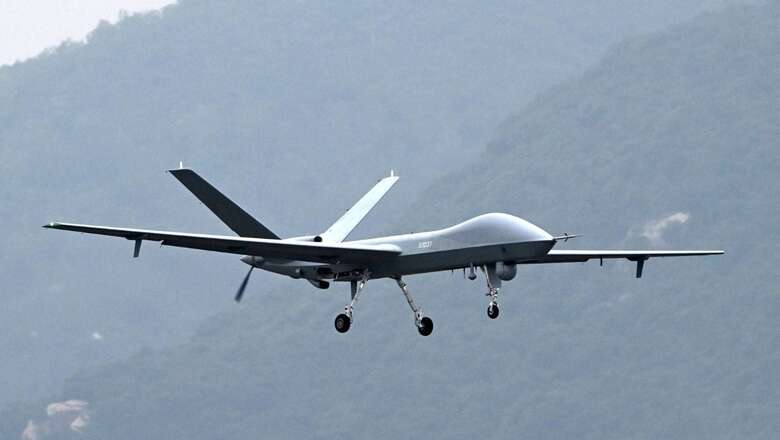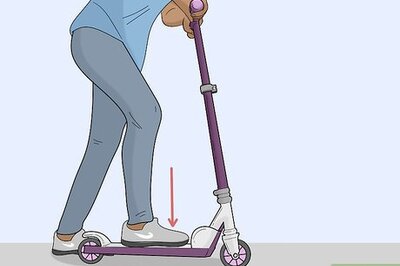
views
Narco trafficking is innovative. Just as drones revolutionized aerial delivery of drugs, the advent of narco submarines has made seaborne drug trafficking cost effective.
The induction of drones by Pakistan-based terror groups and the Inter-Services Intelligence (ISI) made it easy to ferry drugs into Kashmir and Punjab. These aerial vehicles are used to deliver up to 3 kilograms of Heroin in the border areas of Kashmir and Punjab without human involvement. Even small arms and communication equipment are being ferried to terrorist groups in Kashmir and Punjab. Security forces find it extremely difficult to detect and destroy these low-flying drones. Moreover, new technologies are yet to be developed to detect and destroy drones.
Meanwhile, narco submarines are low-profile vessels (LPVs), also known as semi-submersibles. These are designed to run exceptionally low in the water to avoid detection, but they cannot fully submerge. The submarine’s cylindrical hull, sealed roof hatch and hydroplanes all point to some degree of submerged running. Underwater, it uses batteries to power two electric motors. Ten tons of batteries give it an endurance of 12 hours, which would enable the craft to travel about 32 nautical miles, if the submerged speed is around three knots. But this is not sufficient to ferry drugs over long distances, hence a towing ring fixed on the nose points enables the craft to be towed by a larger vessel to a location near its destination. They then make the final leg on its own.
The UNDOC has so far identified two types of water drones. One is fully submersible and the other is a surface vessel. Submersibles can transport 100 to 200 kilograms (up to 440 pounds), while surface vessels can carry more than 320 kilograms (about 705.48 pounds). These narco subs are routinely used to move drugs to Central America and Europe, as well as other South American countries namely Brazil and Guyana. The submarines are generally packed with drugs and manned by small crews who embark on long journeys, lasting several weeks underwater, in an attempt to evade detection by naval and coast guard forces.
Over the years, drug cartels have invested heavily to improve the seaworthiness and technologies employed in building these boats. Many narco subs are now capable of transporting drugs from South America to European countries. The subs now have global positioning systems and communications equipment to successfully cross the Atlantic Ocean, resupply in the sea and arrive at the exact point in Europe where the cargo must be delivered. Larger manned vessels have been interdicted that carried up to 8 tons of cocaine.
These crude submarines are fabricated in secret workshops deep in the mangrove swamps of north-western Pacific coast, notoriously difficult for navy patrols or radar to detect. The labyrinth of mangroves that make up 80% of Colombia’s Pacific coast provide ideal cover for the small boatyards where the submarines are made.
A typical narco sub is about 45ft long, built of fibreglass over a marine plywood frame and weighs seven tons. It’s capable of carrying 1.6 tons of cocaine at a steady speed of 10 knots for thousands of miles without refuelling. When laden, three-quarters of the hull is underwater. The subs are camouflaged with dark grey or blue-green paint which makes them almost invisible to spotter planes and makes them difficult to pick up on radar. An exhaust system funnels the hot fumes generated by the engines down into the water, so they don’t show up on thermal detection equipment.
Due to the extreme inhospitable living conditions, these subs are known as ‘water coffins’ or ‘tombs’ and a narco sub trip is referred to as a journey to hell. Each sub has three or four crew members (one or two to steer and navigate, one to look after the engine and another the cargo) who share a space about 10ft by 10ft — ‘hot-bunking’ with two sleeping on mattresses on top of the petrol tanks, while the other two steer the vessel with a conventional ship’s wheel and monitor progress. It’s claustrophobic — they either relieve themselves on board or through the tiny cabin windows. The powerful and deafeningly noisy diesel engines are just a few feet away (along with thousands of gallons of fuel), maintaining the cabin temperatures at unbearable levels. During their perilous voyages, which last 8-10 days, the crew has to live off canned food, bottled water and the very occasional gulp of fresh air.
Security agencies have sufficient reason to believe that terrorist organizations could seek to leverage the potential of narco subs to carry weapons or parts of weapons of mass destruction, biological warfare agents and chemical weapons, as narco submarines are designed to avoid detection and capture. Hence, many nations have put in place suitable laws to tackle the threat posed by narco subs and other lethal submersibles.
The Drug Trafficking Vessel Interdiction Act of 2008, passed by the U.S. Congress declared that operating or embarking on a submersible vessel of any kind is a serious threat to national security.
A 2009 law added articles in the Colombian penal code that award six to 12 years in prison to those who “build, sell and/or have semisubmersibles or submersibles. Unauthorized financing, construction, stores, sells, transports, buys or uses a semisubmersible or a submersible”.
India does not have any kind of law to tackle the grave threat posed by narco-subs. A news report in Daily Mail on July 24 has the disturbing revelation that drug cartels of Colombia are hiring boat engineers and designers, including recruits from Russia, Pakistan and Sri Lanka, to oversee the mass-production of the subs in factories located in the remote corners of the Colombian jungle. It may not take much time for the ISI of Pakistan to requisition the expertise of these Pakistanis to start sending Heroin laden narco subs to India’s western coast, Lakshadweep islands, as also Sri Lanka and Maldives.
Combating narco-submarines is going to be a new challenge for the Indian Navy, Coast Guard, Customs and Coastal Police and all other enforcement agencies. India will need a multiagency and multinational strategy to keep a taskforce in operational readiness to counter ISI’s diabolical manoeuvres.
This writer has long been advocating setting up of a separate Ministry of Counter Narcotics for the narcotics warfare happening all around us, in the hills of Kashmir, Manipur, the remote islands of Lakshadweep, at airports, seaports, inside containers, educational campuses and resorts.
The drug infiltration is happening on the coastal belt, international land borders, in the skies, and soon it will happen from under the seas.
Dr. G. Shreekumar Menon IRS (Rtd), Ph.D. (Narcotics), is Former Director General, National Academy of Customs, Indirect Taxes & Narcotics. Views expressed in the above piece are personal and solely that of the author. They do not necessarily reflect News18’s views.




















Comments
0 comment